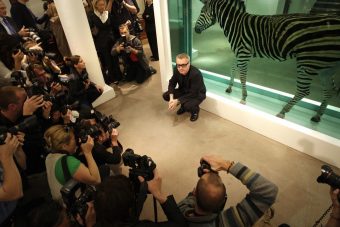How Damien Hirst’s $200 Million Auction Became a Symbol of Pre-Recession Decadence

On September 15, 2008, Sotheby’s was set to auction off 223 brand new works by Damien Hirst, including top-flight examples of his whole animals in formaldehyde, medicine cabinets, and spin paintings. It was an unprecedented incursion by an auction house into the primary market, and an unabashedly flashy sale accompanied by a global marketing tour with stops in Kiev, Aspen, and New Delhi. Sotheby’s produced a three-volume catalogue that cost approximately $240,000 to produce and put on a party for 1,500 guests, who nibbled foie gras wrapped in gold leaf. The auction was expected to bring in at least $120 million over an evening and day sale, with a high estimate of $176.5 million.
The morning of the sale, Lehman Brothers announced it was closing its doors with more than $600 billion in debt, the largest bankruptcy in U.S. history and the beginning of a financial crisis that would cause unemployment to top 200 million for the first time in history, wipe out $16 trillion in American wealth, and send the art market into a spiral that knocked $15 billion from its total sales.
The Hirst auction, which the artist had dubbed “Beautiful Inside My Head Forever,” exceeded all expectations, grossing $200.75 million over the course of two sales in the span of 24 hours and becoming the most expensive single-artist auction ever. The 56 lots at the evening sale went 97% sold, and the two lots that did not find buyers during the auction were sold before the night was over. Over a third of the buyers had never bought contemporary art before. On the cusp of a global recession, Hirst walked away with $172 million.
“I love art and this proves I’m not alone and the future looks great for everyone!” Hirst said in a statement after the sale, during which he was playing snooker at London’s Groucho Club, his personal assistant relaying the prices while on the phone.
Flooding the market with hundreds of works may have hurt his prices at auction, and ten years on, “Beautiful Inside My Head Forever” is remembered as a defining moment in the pre-recession contemporary art boom. It was a last gasp of decadence, punctuated with $18 million stuffed cows, and a risk that nearly torpedoed Hirst’s sky-high career.
But with Hirst’s market enjoying a healthy resurgence in 2018, the go-for-broke strategy that he perfected with the sale is still novel a decade later.
Damien Hirst had a history with Sotheby’s. In 2003, a pill-themed London restaurant called Pharmacy—a clubby spot that Hirst invested in, filled with his medicine cabinet works and butterfly paintings, and had a hand in designing—went belly-up.The restaurant’s current owner was planning on dumping all the ephemera—floorboards, lighting fixtures, cutlery, matchbooks—that had been, at least to some extent, designed by Hirst in the pharmaceutical theme. At the last minute, Hirst’s accountant and manager Frank Dunphy ran over to the restaurant and bought everything for £50,000. If they could sell the Hirst artworks that hung in Pharmacy, perhaps he could sell the Hirst-designed matchbooks and martini glasses, too.
Sotheby’s Oliver Barker, who at the time was a senior director in the contemporary department, suggested a very unusual kind of auction, which came to him as a vision when passing the shuttered Pharmacy space on the bus to work with his wife.
“I just had a brain flash: That could be an incredible auction,” Barker, who is now co-chairman of Sotheby’s European operations, told Artsy this week. “He could have gone to White Cube or Gagosian to sell butterfly paintings from the Pharmacy restaurant, but the only way to attract the highest value for all the fixtures—the costumes and the glassware and the furniture and the flooring—was really through auction.”
Dunphy was able to convince Hirst to go along with demented gambit, and when the sale was announced in July 2004, the British rags had a field day making fun of the ambitious prices listed for bizarre tableware and decor. “Anyone with a heartfelt yearning for a stool in the shape of an aspirin need not go away empty-handed: a set of six could be yours for a mere £700,” The Guardian wrote at the time. But then something wild happened—when the bidding opened in October 2004, everything sold, and for prices remarkably above the estimates. When Barker opened bidding on the first lot, a pair of martini glasses estimated to sell for £50 to £70, the paddles exploded, and bidding pushed the price to £4,800, nearly 100 times the low estimate. A pair of salt and pepper shakers, estimated to sell for an already pricy £40 if you considered how easy it would have been to steal them after dinner were you so inclined—well, they sold for £1,920. In total it made £11.13 million ($20.06 million), more than double the high estimate.
Hirst, who didn’t bother to show up, told Dunphy, “Suddenly my restaurant venture seems to be a success.”
When Barker noted it was the first and only time a living artist had consigned all of the work in a single auction, it gave Hirst and his business manager an idea.
Show site
